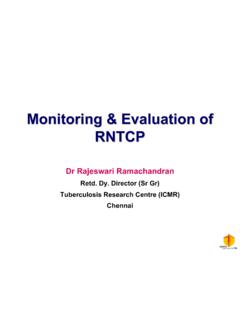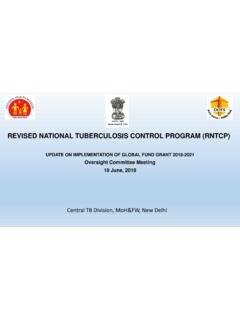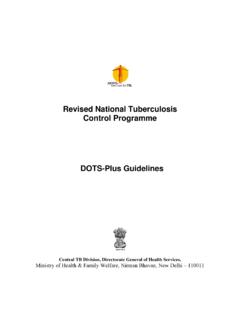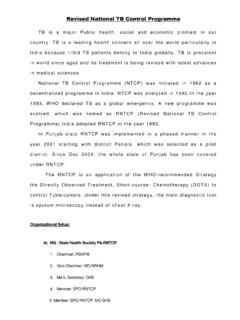Transcription of Report of the Joint TB Monitoring Mission, India, 2015
1 1. Report of the Joint TB Monitoring Mission, India, 2015. 2. Table of Contents List of Abbreviations ACSM advocacy, communication and social mobilization AIC airborne infection control ANM auxiliary nurse midwife ART antiretroviral therapy ASHA Accredited Social Health Activist C/DST culture and drug susceptibility testing CBCI-CARD Catholic Bishops' Conference of India Coalition for AIDS andRelated Diseases CBNAAT cartridge-based nucleic acid amplification test CBO community-based organization CCT conditional cash transfer CDR case detection rate CLHIV children living with HIV/AIDS. CPT co-trimoxazole preventive therapy CSO civil society organization CTD Central tuberculosis Division DALY disability-adjusted life year DCGI Drugs Controller General of India DFID Department for International Development DMC designated microscopy centre DOT directly observed treatment DOTS directly observed treatment, short-course DRS drug resistance surveillance DR-TB drug-resistant TB.
2 DST drug susceptibility testing DTO district TB officer DTU district tuberculosis unit EQA external quality assurance FAQs frequently asked questions FDC fixed-dose combination FIND Foundation for Innovative Diagnostics FLD first-line drug FM fluorescent microscopy GDF Global TB Drug Facility GoI Government of India HRD human resource development IAP Indian Academy of Paediatrics ICDS Integrated Child Development Services ICT information and communications technology ICTC integrated counselling and testing centre IEC information, education and communication IGRA interferon-gamma release assay IMA Indian Medical Association IMNCI Integrated Management of Neonatal and Childhood Illness INH isoniazid IPC interpersonal communication IPT isoniazid preventive therapy IRL intermediate reference laboratory 3. JALMA national JALMA Institute of Leprosy and otherMycobacterial Diseases JMM Joint Monitoring Mission KAP knowledge, attitude and practice LED-FM light-emitting diode-based fluorescence microscopy LIMS laboratory information management system LPA line probe assay LRS Lala Ram Sarup Institute of tuberculosis andRespiratory Diseases MCH maternal and child health MCI Medical Council of India MDG Millennium Development Goal MDR multidrug resistance MO medical officer MoHFW Ministry of Health & Family Welfare MPW multipurpose worker NACO national AIDS control Organization NACP national AIDS control Programme NCDC national Centre for Disease control NEP new extrapulmonary (TB).
3 NGO non-governmental organization NIFHW national Institute of Health and Family Welfare NIRT national Institute for Research in tuberculosis NRHM national Rural Health Mission NRL national reference laboratory NSN new smear-negative NSP national Strategic Plan NTI national tuberculosis Institute NTWG national Technical Working Group OTC over the counter PHI peripheral health institution PI protease inhibitor PLHIV people living with HIV/AIDS. PMDT programmatic management of drug-resistant TB. PP private health-care provider PPD purified protein derivative PPIA private provider interface agencies PPM public private mix PPP public private partnership PWB patient-wise box QA quality assurance RNTCP revised national tuberculosis control Programme RSBY Rashtriya Swasthya BimaYojana SACS State AIDS control society SAP social action plan SHG self-help group SLD second-line drug SL-DST second-line drug susceptibility testing STC State tuberculosis cell STDC State TB training and demonstration centre STLS senior tuberculosis laboratory supervisor STO state tuberculosis officer STS senior TB treatment supervisor 4.
4 TB tuberculosis TBHV tuberculosis health visitor TSG technical support group TST tuberculin skin test TU tuberculosis unit UNAIDS Joint United Nations Programme on HIV/AIDS. UNITAID International facility for the purchase of drugs to treatHIV/AIDS, malaria and TB. USAID United States Agency for International Development WCO WHO Country Office WHO World Health Organization XDR extensively drug-resistant YLL years of life lost 5. Executive Summary This Report contains the findings, conclusions, and recommendations of the fifth Joint Monitoring Mission (JMM) of the revised national tuberculosis control Programme (RNTCP). The JMM brought together national and international experts, affiliated Departments from the Ministry of Health, civil society, implementing partners, technical and developmental agencies to review the progress, challenges and plans for India's TB control efforts. The Government of India (GoI), along with all the Member States of the World Health Organization (WHO), adopted the End TB Strategy in May 2014, thus committing to put an end to the global TB.
5 Epidemic. This is a great responsibility for India, which bears a quarter of the global burden of the disease. Meeting the milestones and targets of the End TB Strategy will require implementing bold policies that guarantee access to high-quality TB care and prevention to all who need it. India will need to address persistent health system weaknesses and the determinants driving the TB epidemic. The country must also play its part in research and innovation to develop and use better tools and strategies for TB care and prevention. The End TB Strategy effectively calls for a major transformation of India's current approach to tackling TB. If it succeeds, India will lead the world in removing TB as a Captain of the Men of Death . Achievements India's achievements in tuberculosis (TB) control over the past decade are remarkable by any measure. More than 80 million people have been tested, 15 million TB patients detected and treated, and millions of lives saved by the RNTCP's efforts.
6 India has an ambitious national Strategic Plan (NSP) to achieve Universal Access to quality TB diagnosis and treatment; this NSP has guided activities and created accountability against results. India achieved complete geographical coverage for diagnostic and treatment services for multi-drug resistant TB (MDR-TB) in 2014, with a remarkable 66,000 MDR-TB diagnosed and put on treatment in the last three years. The nation's first national anti-TB drug resistance survey is being conducted by NTI, Bangalore. The RNTCP and the national AIDS control Organization (NACO) have made HIV-TB collaboration efficient and effective; most TB patients registered by RNTCP receive HIV screening, and more than 80% of HIV-infected TB patients receive anti-retroviral treatment (ART). The GoI boldly banned serological tests for diagnosis of active TB, saving countless persons from inaccurate test results and unnecessary expense.
7 The Government has developed and adopted unifying Standards for TB Care in India', applicable for public and private sector alike. Since TB became a notifiable disease in 2012, private providers nationwide have notified nearly 230,000 TB patients. The RNTCP rolled out an innovative and visionary electronic recording and reporting system (Nikshay) across the country, with 98% of reporting units sending incase-based reporting of TB patients, including notifications from private providers. Innovative approaches, including interface agencies and e-voucher systems for free drugs, have been successfully deployedas pilots to engage more private providers and improve quality of care. Modern media are being creatively used for TB control with Amitabh Bachchan's campaign, TB Harega, Desh Jeetega , with commendable investments by the Ministry and corporations to broadcast these messages. Throughout, RNTCP has demonstrated unprecedentedfinancial absorption capacity.
8 While allocations have been lower than requested, whatever was allocated has been spent. During the 6. three years of the NSP it has managed to disburse (spend and release to states) all of the ,624. crores received. The health and economic benefits of the RNTCP have been enormous, with an estimated USD$350 billion in economic gain over 2006-2015 relative to the absence of RNTCP. services. The Burden of TB. Each year, 12 lakh Indians are notified with newly diagnosed TB and at least lakh Indian citizens die. Some estimates calculate deaths twice as high. TB can affect any age, caste or class but cases are mainly poor people and mostly men. Slum dwellers, tribal populations, prisoners,and people already sick with compromised immune systems are over-represented among the cases, compared to their numbers in the population. Childrencomprise 40% of the population, but are currently under-diagnosed in India. The WHO estimates that another 10 lakh Indians with TB are not notified.
9 Again, this could be even higher. Surveys have shown that many people with TB remain in the community, untreated. Yet case reporting has gently declined since 2009. MDR TB is emerging as a massive organisational and financial challenge to the RNTCP. The economic burden is vast between 2006 and 2014, TB cost the Indian economy a staggering USD340billion. The average cost to a family of any member with TB can amount to as much as 39%. of annual household expenditure a catastrophe for any family already impoverished. Yet every rupee invested in TB control has a one-hundred-fold economic return on investment. The Challenges The JMM 2015 has observed that the implementation of the NSP for 2012-2017 is not on track: projected increases in case detection by the RNTCP have not occurred, vital procurements are delayed and many planned activities have not been implemented. Similarly, the JMM observed that of the recommendations of JMM 2012,about two thirds have not been fully implemented.
10 For the most part, CTD has completed the policy work requested. Work is held up for lack of timely decisions, especially at central level. The ambitious expansion of resources planned under the NSP, 2012-2017 would triple the expenditure of the prior plan, but has not been matched by allocations. While RNTCP expenditure has increased 27% since 2012, there is a growing gap between the allocation of funds and the minimum investment required to reach the goals of the Plan. If this trend continues, final expenditure on the Plan would reduce to Rs. 3,000 crores, or two thirds of the minimum required. Accordingly, while bold policies are mostly in place, many planned activities have not been implemented, and anticipated increases in case finding have not realized. The private sector is massive, heterogeneous, and growing. Over 70% of people with TB first attend this sector, yet substantial diagnostic delays occur, and diagnosis and treatment are of variable quality.












